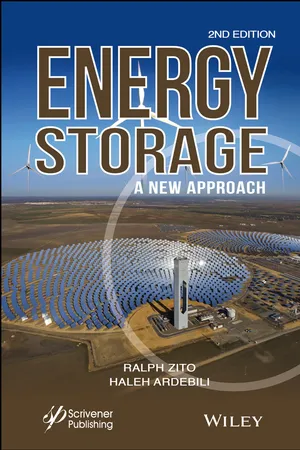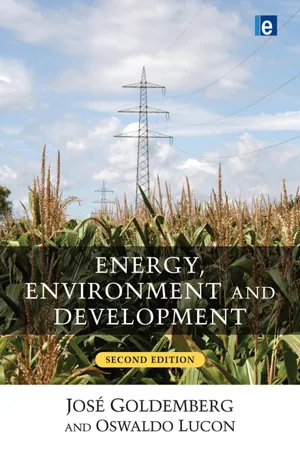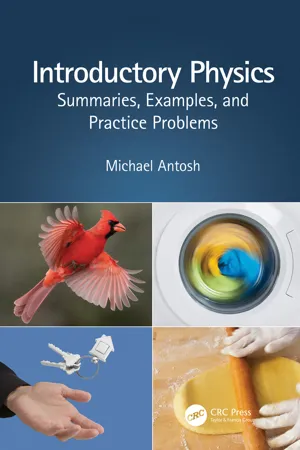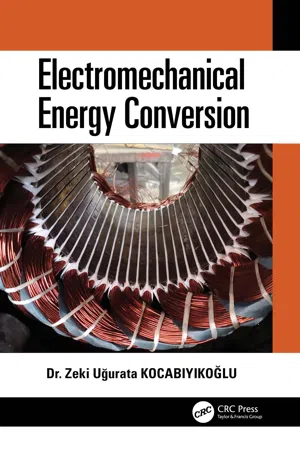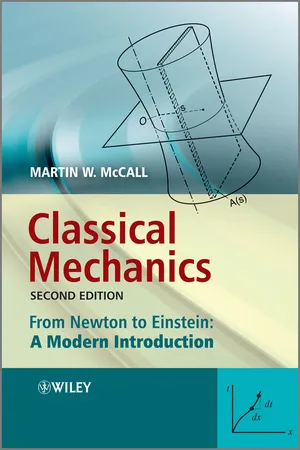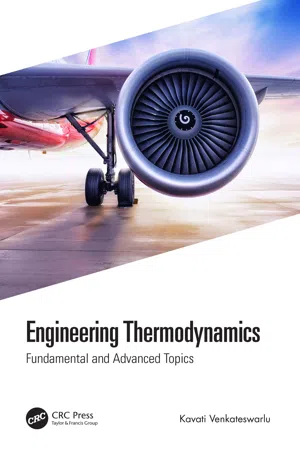Physics
Power Physics
Power in physics refers to the rate at which work is done or energy is transferred. It is measured in watts and is the product of force and velocity. In simple terms, power is the amount of energy converted or transferred per unit time, and it plays a crucial role in understanding the dynamics of various physical systems.
Written by Perlego with AI-assistance
Related key terms
Related key terms
1 of 4
Related key terms
1 of 3
8 Key excerpts on "Power Physics"
- eBook - ePub
Energy Storage
A New Approach
- Ralph Zito, Haleh Ardebili(Authors)
- 2019(Publication Date)
- Wiley-Scrivener(Publisher)
The history of the development of physical concepts is not the prime concern here, but some knowledge of their evolution does serve to bring more closely to our attention and scrutiny a better appreciation of terms that we employ daily. Sometimes it is necessary to begin understanding or developing a body of knowledge in order to make certain basic assumptions on an entirely intuitive basis. As scientifically unsatisfying as that may be, it is unavoidable at times. One could draw a weak comparison to plane geometry (Euclid) with regard to its various axioms and the declaration that parallel lines never meet. Even the concept of straight lines is rather intuitive in nature.Perhaps the best definition is that a force is required to change the motion of a body. Many problems arise in finding acceptable definitions for the basic parameters of physical science, namely, the abstract concepts of mass, time, force, and energy. However, we must learn to be satisfied with definitions that leave something to be desired in order to move on toward generating a working body of mechanics that enables us to design and build practical devices that serve our purposes.An interesting definition of energy comes from the Grolier Encyclopedia, which states:Energy can be measured in terms of mechanical work, but because not all forms of energy can be converted into useful work, it is more precise to say that the energy of a system changes by an amount equal to the net work done on the system … In classical physics, energy, like work, is considered a scalar quantity; the units of energy are the same as those of work. These units may be ergs, joules, watt-hours, foot-pounds, or foot-poundals, depending on the system of units being used. In modern science, energy and the three components of linear momentum are thought of as different aspects of a single four-dimensional vector quantity, much as time is considered to be one aspect of the four-dimensional space-time continuum … Energy exists in many different forms. The form that bodies in motion possess is called kinetic energy. Energy may be stored in the form of potential energy, as it is in a compressed spring. Chemical systems possess internal energy, which can be converted by various devices into useful work; for example, a fuel such as gasoline can be burned in an engine to propel a vehicle. Heat energy may be absorbed or released when the internal energy of a system changes while work is done on or by the system. (1993) - eBook - ePub
- Jose Goldemberg, Oswaldo Lucon(Authors)
- 2009(Publication Date)
- Routledge(Publisher)
Thomas Young (1773–1829) adopted the word Energy in 1807, from the Greek energeia (at work or in activity), to unify the aspects observed on heat and work. James P. Joule (1818–89) determined the energy equivalence between heat, work and electric power (1 calorie = 4184 joules). Max Planck (1858–1947) clarified the energy characteristics of light. Finally, Albert Einstein developed the theory of relativity, unifying all the forms of energy and providing them with an equivalence in mass, in the form E = mc 2 (mass of an electron at rest = 511 ketoelectron volts (keV)). Thus Energy may be defined as the capacity to produce work. Work, in turn, is the result of the action of a force on the displacement of a body. The energy may be kinetic (from the force deriving from waves and winds), gravitational (from waterfalls), electric (from turbines and batteries), chemical (obtained from exothermic reactions, such as diesel and gasoline combustion), thermal (from burning charcoal or wood), radiant (from sunlight) and nuclear (obtained from the fission of uranium atoms or the fusion of hydrogen nuclei). Some forms are more useful than others; several can be transformed. The energy obtained from a nuclear reaction may be used to heat water and produce high pressure steam which, in turn, can produce work to move a turbine to produce electricity. We need energy to live and our needs are better supplied with more energy. Isaac Newton (1642–1727) named force as any agent capable of causing bodies to move and went further to establish a relationship that says which force is necessary to cause a certain movement 2 : force (F) = mass (m) × acceleration (a). Frequently, it is not enough to apply a force to a body to make it move. It is necessary to keep it there while it moves. A wagon needs horses to pull it, overcoming the obstacles and the friction provided by the road - eBook - ePub
Introductory Physics
Summaries, Examples, and Practice Problems
- Michael Antosh(Author)
- 2023(Publication Date)
- CRC Press(Publisher)
You bowl a bowling ball at 5.00 m/s, with a force of 80.5 N in the same direction as the velocity. What is the power?Solution:Here, we have force and velocity, so we use:Power = F∙v∙cos(θ)(6.10.3)Put in numbers: Power = (80.5 N)∙(5.00 m/s)∙cos(0) = 403 Watts6.11 Chapter 6 Summary
Energy is involved in motion. Work done by a constant force (that stays the same during the problem) is:W = F∙Δx∙cos(θ)(6.2.1)In this equation, W is the work, F is the magnitude of force F, Δx is the magnitude of vector Δx, and the angle θ is the angle between the direction of F and the direction of Δx.Work done by a spring force is:Wspring = ½∙k∙xi 2 – ½∙k∙xf 2 (6.3.1)In this equation, k is the spring constant, xf is the distance of stretching or compressing at the final time point, and xi is the distance of stretching or compressing at the initial time point.The net (total) work on an object can be calculated in two different ways:Wnet = Σ Weach force (6.4.1)Wnet = Fnet ∙Δx∙cos(θ)(6.4.2)The first equation means to add the work from each force, and the second equation is the same as Equation 6.2.1 except for using net force instead of one force at a time. Equation 6.4.2 is for constant forces only.Kinetic energy happens when things are moving:KE = ½∙m∙v2 (6.5.1)In this equation, KE is kinetic energy, m is mass, and v is velocity (more specifically, the magnitude of velocity). If you are looking at two time points, you can look at the change in kinetic energy:ΔKE = ½∙m∙vf 2 – ½∙m∙vi 2 (6.5.2)Kinetic energy and net work are related through the work-kinetic energy theorem:Wnet = ΔKE(6.6.1)Wnet = ½∙m∙vf 2 – ½∙m∙vi 2 (6.6.2)Equation 6.6.2 comes from putting the equation for ΔKE (Equation 6.5.2) into Equation 6.6.1.Potential energy comes from conservative forces, which include gravity and springs.Springs: ΔPE = ½∙k∙xf 2 – ½∙k∙xi 2 (6.7.1)Gravity: ΔPE = m∙g∙Δh(6.7.2)Mechanical energy is equal to kinetic energy plus potential energy:ME = KE + PE(6.8.1)Similarly, the change in mechanical energy is equal to: - eBook - ePub
- Robert Lambourne(Author)
- 2019(Publication Date)
- CRC Press(Publisher)
instantaneous power, and is what is usually meant by the unqualified term ‘power’. It may be thought of as the gradient of a graph of energy transfer against time and may be written in terms of a derivative as followsP =(2.37).d Wd tThis is usually described as the limit ofas Δt tends to zero.Δ WΔ tFrom Equation 2.36 we see that:Δ W =〈 P 〉Δ t .This means that we could use the watt second (W s) instead of the joule (J) as an SI unit of work or energy. In practice, the watt second unit is rarely used, but the kilowatt hour (kW h) is commonly used as the commercial unit for the measurement of electrical energy consumption. One kilowatt hour is the energy transferred or work done in one hour when the power is 1 kW, so:1 kW h =10 3Js× 3600 s = 3.600 ×− 110 6J = 3.600 MJ .4.2 Power and vectorsThe work done by a constant force F over a small displacement Δs is:Δ W = F ⋅ Δ s .(2.38)The average power delivered by that force over the time Δt is:〈 P 〉==Δ WΔ t= F ⋅( F ⋅ Δ s )Δ t.Δ sΔ tThe instantaneous power is given by the limit of this as Δt tends to zero, soP =(2.39)= F ⋅d Wd t(= F ⋅ v .)d sd tSinceF ·v = Fv cos θ , an immediate consequence of this is that the rate of energy transfer by a force F acting on a body which is moving in a direction perpendicular to F must be zero, since θ = 90° in that case and cos 90° = 0. Some other consequences are explored in the following questions.Question 2.17 The three engines of an airliner can develop a total take-off thrust (force) of magnitude 6.72 × 106 N. If the speed at take-off is 90 m s−1 , calculate the power developed at take-off.Question 2.18 A horse pulls a barge along a canal at a constant speed of 2.0 m s−1 . The force due to the tension in the tow rope is 300 N and the rope makes an angle of 30° to the direction in which the barge travels. What power does the horse supply? ■ - eBook - ePub
- Zeki Uğurata Kocabiyikoğlu(Author)
- 2020(Publication Date)
- CRC Press(Publisher)
1 Basic Principles of Energy, Power and Electrical Power Systems1.1 Physical Foundations of Energy and Power
1.1.1 Energy
Here, we shall provide a reminder about- what energy is
- how it changes
- how electrical energy is obtained.
Energy is defined as the “capacity of a system to do work”. The most common unit used for energy is joule, abbreviated J. Electric utilities bill the energy in kilowatt hours (kWh). A kWh represents “one kW being used for one hour”, and it equals 3.6 MJ of energy. Energy can exist in many forms like heat, light, sound, mechanical, and electrical. It cannot be consumed but can be converted from one form to another. This is the law of “conservation of energy” described in the “first law of thermodynamics”. Whenever energy changes from one form to another, some of it is lost as heat. This is because energy transformations are not energywise reversible. Heat is a disorderly form of energy. On the other hand, electrical energy, kinetic energy, and potential energy are orderly forms of energy.Orderly forms of energy can easily be converted to heat. For example, electrical energy can be easily converted to heat by making a current flow in a resistor or by dropping a stone from a hill onto a hard surface and converting partially its kinetic energy to heat. On the other hand, transforming heat into electrical energy is much more difficult.The second law of thermodynamics says that “nature has a tendency towards disordered forms of energy”. This means that converting heat to electricity will not be as efficient as converting electricity to heat. About 60% of the heat energy input to power plants is lost as waste. Energy can be in the form of “kinetic energy” as in the case of a truck travelling down the hill, or it can be in the form of “potential energy” as in the case of a skier standing at the top of a hill (Figure 1.1 - eBook - ePub
The Thermal Human Body
A Practical Guide to Thermal Imaging
- Kurt Ammer, Francis Ring(Authors)
- 2019(Publication Date)
- Jenny Stanford Publishing(Publisher)
thermoelectric effect encompasses three separately identified effects: Seebeck effect, Peltier effect, and Thomson effect. These effects describe the direct conversion of temperature differences to electric voltage and vice versa.For thermal energy, 1 Joule is expressed as the 1/4.184 part of heat energy required to raise the temperature of a unit weight (1 g) of water from 0°C to 1°C. 4.184 Joules are equal to the traditional unit of 1 calorie.There are relationships between heat and electromagnetic radiation, and thermal energy and chemical energy.Above the absolute zero-point of −273.15°C, everything, solid material, fluids, gases and living beings, emits to some extent radiant heat in the form of infrared waves. Chemical energy is related to the structural arrangement of atoms or molecules and represents the energy of chemical bonds and is equal to the amount of the heat required to break one mole of molecules into their individual atoms. Potential energy is a property of a system representing stored energy that depends upon the relative position of various parts of a system.2.3What Is Power?Physically, power [W] is work or energy per time unit. In the case of mechanical energy per time unit it is called mechanical power or, particularly in thermal, sports and occupational physiology, work rate and attributed the letter W [4 ]. The heat equivalent to power is heat flux with the official unit watt (W), which is the power corresponding to 1 joule per second. The kilocalorie per hour (kcal/h) must be avoided.Understanding power enables to follow the process of heat exchange.2.4Energy Conversion and Heat TransferAn excellent description of the history of thermodynamics was published by I. Müller [5 ].2.4.1First Law of ThermodynamicsThe first law of thermodynamics states that the various forms of energy can be changed from one form to another but cannot be created or destroyed. In other words, the total sum of the energy is stable over time irrespective of number of energy transformations. If a system has received, say, mechanical energy, W, and if its internal energy, E, has not changed, the system must has lost an equivalent amount of some other energy, e.g. heat, Q. - eBook - ePub
Classical Mechanics
From Newton to Einstein: A Modern Introduction
- Martin W. McCall(Author)
- 2011(Publication Date)
- Wiley(Publisher)
Ft .Another quantity sometimes introduced is the rate of doing work:- Power, P , is the rate of doing work:
(2.15)The SI unit of power is the watt, equivalent to the rate of working at 1 joule per second. Power is sometimes used in contexts where no net force is acting, which can be a little confusing. When we drive a car along the road with the accelerator depressed it moves because a constant force is applied to the wheels through the burning of fuel. However, resistance from the road and the rotary motion of the car’s transmission opposes the car’s motion so that in the steady state no net force is applied. According to Newton’s first law the car then moves with constant velocity, and the power developed by the engine is that required to overcome friction and to maintain the car’s speed. Perhaps the right pedal would be better named the ‘velocirater’!2.6 Motion with a Position-dependent ForceAlthough we’ve worked it out for a constant force, the definition covers the case F = F (x ) as well. Many forces depend on the location of a body and not explicitly on time or the body’s velocity. We refer in such cases to a field of force. Gravity is the most familiar example, though we have to go to a height that is comparable with the Earth’s radius before the acceleration due to gravity changes noticeably. In the context of one-dimensional motion, the position dependence is with respect to a single spatial variable, which we call x . Unlike the case of position-independent forces, m = F (x ) can no longer be integrated with respect to time directly (since x = x (t )), so we must proceed differently. First, let us generalise the definition of work from Equation (2.9 - eBook - ePub
Engineering Thermodynamics
Fundamental and Advanced Topics
- Kavati Venkateswarlu(Author)
- 2020(Publication Date)
- CRC Press(Publisher)
There is a work transfer into the system, since the current can drive a motor, the motor in turn can drive the pulley which can raise a weight. The current flow is represented by FIGURE 3.6 Electrical work. I = d C d t (3.25) where dC is the charge (in coulombs) crossing the boundary in time interval dt. Then the work is δ W = E ⋅ d C (w h e r e E i s t h e v o l t a g e) (3.26) = E ⋅ I d t On integration ⇒ W = ∫ 1 2 E I d t (3.27) The electrical power is given by W ˙ = lim d t → 0 d W d t = E I (3.28) and it is the rate of work transfer. Stirring work : Let us consider the case of stirring of a fluid system when there is a work transfer into it due to the turning of the paddle wheel as the weight is lowered as shown in Figure 3.7. If m is the mass of the weight lowered through a distance dl and T is the torque transmitted by the shaft due to its rotation through an angle dΘ, then the differential amount of work transfer to the fluid system is FIGURE 3.7 Paddle-wheel work. δ W = mgdl = T ⋅ d Θ The total work transfer is W = ∫ 1 2 m g d l = ∫ 1 2 W 1 d l = ∫ 1 2 T d θ (W 1 i s t h e w e i g h t l o w e r e d) (3.29) Shaft work : Let us consider an energy transmission with a rotating shaft as shown in Figure 3.8. The work done during ‘n’ revolutions for a constant torque T and force F is determined as FIGURE 3.8 Shaft work. T = F ⋅ R then F = T r (3.30) When s is the distance through which a force acts which is related to radius r as s = (2πr)n, then the shaft work W = F ⋅ s = (T r) (2 π r) n (3.31) The power transmitted through the shaft is the work done per unit time. W = 2 π n T (3.32) where n is the number of revolutions per unit time. Spring work: Whenever a force is applied on a spring, its length changes
Index pages curate the most relevant extracts from our library of academic textbooks. They’ve been created using an in-house natural language model (NLM), each adding context and meaning to key research topics.
Explore more topic indexes
Explore more topic indexes
1 of 6
Explore more topic indexes
1 of 4
